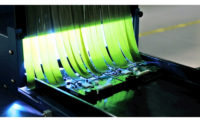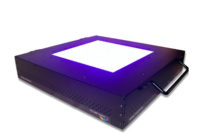Case Study
Innovating with Light
Infrared emitters and UV lamps speed up production and improve quality for a UK-based label manufacturer.

The coating of foils, the printing of labels, or the gluing of electronic components are very different and demanding applications. However, they all require innovative production processes to maintain their appeal, durability and scratch resistance.
Great Britain-based Smith & McLaurin, a leading manufacturer and global supplier of self-adhesive labels, tags and tickets, was able to speed up and improve its production of labels by retrofitting a Heraeus Noblelight infrared system. Based in Johnstone, Renfrewshire, Smith & McLaurin sells reels of materials to printing houses and processors that manufacture finished labels and tags for a range of end users, such as supermarkets, pharmacies, logistics companies, and food-processing companies.
Speeding the Process
An important part of the production process is the application of silicone materials to the label strips. Provided with an adhesive, the silicone is attached to the rear of the label strips and then dried and cured. Previously, this was done using a 20-year-old combined system of infrared and hot-air oven. However, increased demand required higher production line speeds, and the existing infrared oven was unable to keep up.
Smith & McLaurin had been successfully operating a carbon infrared system (CIR) at another line, so the engineers contacted Heraeus and retrofitted a 192-kW CIR oven directly downstream from the existing hot-air oven. The CIR system comprises two 96-kW modules, which were installed above the line; each module is equipped with 15 medium-wave carbon emitters arranged in 10 individually controllable zones. This allows the output to be increased from 0 kW to 192 kW in 10 equal steps to meet the specific requirements of the production process.
“The success of this second infrared installation further increases our confidence in the technology,” says Iain McCourty, engineering manager at the Renfrewshire site. “The ability of the carbon medium-wave system to provide heat instantaneously and uniformly through the applied coatings has ensured that we can now increase line speed. At the same time, the controllability of the system means that we are obtaining a much more reliable, and hence better quality, adhesive cure.”
Efficiently Crosslinking
In order for coatings or inks to remain appealing, durable and scratch-proof, they need to be sufficiently and optimally dried and cured. This requires that wavelengths, as well as UV light intensity and dose, be adjusted to the photoinitiators of the varnish formulation or the coating.
Different UV solutions are available for the pretreatment or curing of inks and coatings. These emit intensive UV light in the wavelength range of 200-400 nanometers. The wavelengths of the lamps are optimized for the photoinitiators of the lacquer system or coating to achieve efficient and sufficient crosslinking. This enables higher production speeds and improved process reliability. The processing of the surface can continue without much delay, and the surface will be scratch resistant and durable at the end of a curing process.
Finding the UV Light
Prior to application of the coating or printing, the surface tension can be reduced and the surface energy increased by means of VUV radiation (vacuum UV). Due to the changed wetting properties, materials can be processed better and faster. After that, the UV coating or printing is cured. Intensive microwave-powered UV medium-pressure systems with appropriate doping or UV-LED systems are used for this. Selection of a suitable UV solution also allows intermediate curing steps. Finally, the surface can be further improved by means of a special UVC cure system. Similar to UV-LEDs, the system emits monochromatic UV radiation in the UVC range. This makes surfaces significantly more scratch resistant.
UV solutions can be used depending on which process step is to be optimized. The use of advanced UV-LED technology is a promising option to lower the energy consumption and heat generation. UV-LEDs are ozone free and long lasting, making maintenance easy and less expensive.
Current developments in UV-LED coatings and lacquers enable curing with UV-LEDs despite the monochromatic spectrum. Conventional UV technologies, such as UV medium-pressure lamp systems, dry and cure paints across a wide polychromatic spectrum with a very high intensity. This allows high speeds and reliable curing processes. The cured paints or inks give the surfaces a brilliant appearance. All UV and IR systems can be used separately or in combination to tailor the drying and curing solution to the application’s requirements. ASI
For more information, visit www.heraeus-noblelight.com.
Looking for a reprint of this article?
From high-res PDFs to custom plaques, order your copy today!





